Lorena Visentainer2,3*, Thalita Machado Carlesso2,3, Thais Oliveira Reis1, Luisa Agrizzi De Angeli1, Fabianna Acerbi Penha1
1Hairdoc Transplante Capilar, Rua Vergueiro, 2016, 4o andar, Liberdade, São Paulo, São Paulo, Brazil
2Hairdoc Transplante Capilar, Avenida Carneiro Leão, 563 – Zona 01, Maringá, Paraná, Brazil
3Hairdoc Transplante Capilar, Avenida Nicomedes Alves dos Santos 1053, Uberlândia, Minas Gerais, Brazil
*Correspondence author: Lorena Visentainer, MD, MSc, Hairdoc Transplante Capilar, Avenida Carneiro Leão, 563 – Zona 01, Maringá, Paraná, Brazil and Hairdoc Transplante Capilar, Avenida Nicomedes Alves dos Santos 1053, Uberlândia, Minas Gerais, Brazil;
Email: [email protected]
Published Date: 04-12-2024
Copyright© 2024 by Arciniegas E, et al. All rights reserved. This is an open access article distributed under the terms of the Creative Commons Attribution License, which permits unrestricted use, distribution, and reproduction in any medium, provided the original author and source are credited.
Abstract
Introduction: Androgenetic alopecia is a dynamic and chronic disorder of hair thinning and loss that affects men and women before the age of 70.
Objective: To describe the technique for preparing follicular progenitor cells (in this case, mesenchymal stem cells) to be used during hair transplantation to optimize the treatment of alopecia since hair follicles are available for clinical stimulation.
Materials and Methods: The follicles sectioned during extraction are separated and subjected to fragmentation steps until they reach a pasty solution and are rehydrated. The solution is then diluted, filtered and homogenized.
Results/Discussion: Both techniques – hair transplantation and the use of mesenchymal stem cells have scientific evidence widely described in the literature. After extraction, the solution containing autologous mesenchymal stem cells is applied to a selected area of the scalp (hair transplant recipient area) after pre-incisions.
Conclusion: Our next studies will describe the phenotyping and mean quantification of hair follicle stem cells by flow cytometry, as well as trichoscopy results and the increase in hair density.
Keywords: Regenerative Transplantation; Alopecia; Mesenchymal Stem Cells; Scalp
Keywords: Regenerative Transplantation; Alopecia; Mesenchymal Stem Cells; Scalp
Introduction
Androgenetic Alopecia (AGA) is a dynamic and chronic disorder of hair thinning and loss that affects approximately 80% of men and 40% of women before the age of 70 [1,2]. It is characterized by gradual miniaturization of the Hair Follicle (HF) resulting from alterations in the dynamics of the hair cycle, leading to a progressive reduction in hair diameter and length [3]. Hair thinning results from the effects of Dihydrotestosterone (DHT) on androgen-sensitive HF. In women, AGA produces diffuse thinning of the crown region with maintenance of the frontal hairline. The male pattern is characterized by bitemporal recession of the frontal hairline, followed by diffuse thinning at the vertex [4].
In recent years, the understanding of the pathophysiology of AGA has expanded and paved the way for improved diagnostic and therapeutic options. In addition to clinical treatments, there is a high demand for surgical treatments, such as hair transplantation and recently, research has highlighted the role of stem cells in the pathophysiology of baldness as a promising and alternative treatment [5]. Stem cells are undifferentiated progenitor cells both biochemically and structurally, have high proliferative potential and are considered multipotent cells [6].
The “Gentile Protocol”, a protocol that uses follicular stem cells, was developed by Professor Pietro Gentile and was studied in Italy by the authors of this article, who developed the technique themselves and now use it during surgical hair transplantation procedures, in the area where the follicles will be implanted [5]. In 2019, Gentile demonstrated that this protocol positively influences hair growth through cell proliferation with prolongation of the anagen phase acting on follicular signaling pathways, observed through the expression of follicular markers. Furthermore, it has also been demonstrated that WNT/β-catenin signaling is essential for the growth and maintenance of dermal papilla cells, being one of the main factors that increase hair growth after the procedure [5].
The regenerative hair transplantation technique is a safe and effective procedure that increases follicular density and the growth of new hairs, in addition to acting against hair loss after transplantation [5]. This study describes the technique for preparing autologous Hair Follicle Mesenchymal Stem Cells (HF-MSCs) to be used during hair transplantation, optimizing the treatment of alopecia, since HFs are available to be clinically stimulated.
Materials and Methods
Around 30 intact and transected follicles during hair transplant extraction are initially separated with a 0.8-0.9 mm punch. Once separated, they will undergo the following steps:
Step 1. Fragmentation of the transected follicles with a size 15 scalpel blade until a pasty solution is formed (Fig. 1)
Step 2. Application of 3 ml of Ringer’s lactate to the solution (Fig. 2)
Step 3. Aspiration of 3 ml of this solution into 2 1.5 ml syringes, with 1.5 ml of the content in each (Fig. 3)
Step 4. Dilution and filtration between the syringes with a 1.2 mm transfer filter for homogenization 20 times (Fig. 4)
Step 5. Centrifugation of the homogeneous content containing autologous cells in a centrifuge at 3000 rpm for 3 minutes
Step 6. Collection of the entire supernatant suspension in a 3 ml syringe (Fig. 5)
Step 7. The content is applied with a 26G needle at a 3-4 mm depth in a selected scalp area to be treated after the pre-incisions, usually the recipient area in hair transplantation (Fig. 6)
Fig. 7 shows the flowchart with the steps of regenerative hair transplantation.
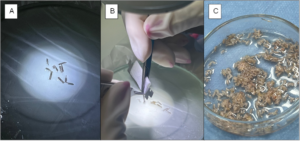
Figure 1: A: Separation of follicles; B: Fragmentation of follicles with a scalpel blade; C: Paste solution with fragmented follicles.
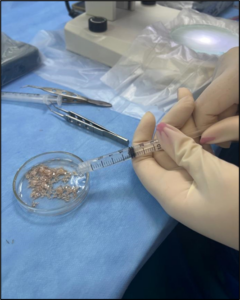
Figure 2: Application of 3 ml of Ringer’s lactate to the pasty solution containing fragmented follicles.
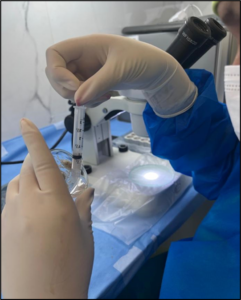
Figure 3: Aspiration of 1.5 ml of the solution into each syringe.
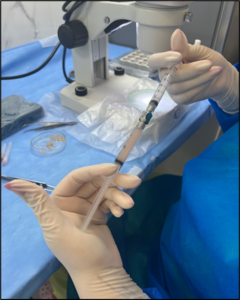
Figure 4: Dilution and filtration between syringes with a transfer filter.
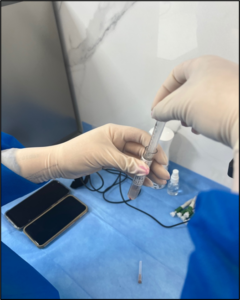
Figure 5: After centrifugation at 3000 rpm for 3 minutes, collection of all supernatant suspension.
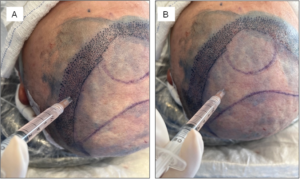
Figure 6: Application of the contents to the scalp after pre-incisions, in the area to be treated.
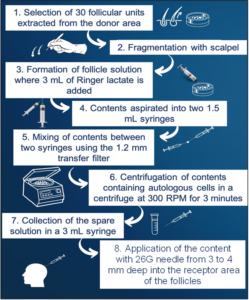
Figure 7: Flowchart of the steps of regenerative hair transplantation.
Results
Both the use of autologous cells and hair transplantation are well-established techniques with evidence in the literature. And the combination of the two will bring a joint and synergistic benefit for the treatment of alopecia. Our next step will be to validate the technique with statistical analysis to quantify and detect the CD44+ and CD200+ stem cell markers and characteristics of HF-MSCs and Epithelial Stem Cells (HF-ESCs), respectively. With this regenerative transplantation technique, we expect rapid healing of the lesions induced during hair transplantation, continuous improvement in hair growth and an approximately shorter telogen phase. Patient follow-up should be performed monthly for 12 months.
Discussion
In our study, we developed a technique for isolating HF-MSCs for subsequent application in the recipient area of hair transplantation. The application of HF-MSCs during hair transplantation is already a procedure presented at several hair transplantation conferences. In October 2021, during his conference at the International Society of Hair Restoration Surgery in Portugal, Dr. Anil Garg presented for the first time a case study, using a different technique from ours, showing the synergistic potential of combining stem cell therapy and hair transplantation, paving the way for new treatment paradigms with traditional hair transplantation. Dr. Garg’s innovative approach involved applying stem cells to the patient’s crown area while simultaneously performing hair transplantation in the frontal region. This dual approach aimed to maximize hair growth in both areas affected by hair loss. The results were truly impressive, with significant hair growth observed in both treated areas.
The understanding of HF biology in recent decades has established the fundamental role of HF-MSCs from dermal papillae in maintaining hair growth and the role of multipotent epithelial and melanocytic stem cells in giving rise to cell proliferation and differentiation [7]. Other autocrine and paracrine factors and signaling pathways are also involved in this interaction between dermal papillae and HF stem cells [7,8]. Bulge stem cells can generate the interfollicular epidermis, follicular structures and sebaceous glands. Bulge epithelial stem cells can also reconstitute themselves into a new HF [9].
In previous work, it was demonstrated that HF-MSCs exhibited surface markers of bone marrow MSCs, showing positive staining for CD44, CD73, CD90 and CD105 and exhibited lineage differentiation potentials into adipocytes, chondrocytes and osteoblasts by cytochemistry [10,11]. The bulge region in HF is also an important site for keratinocyte stem cells and HF-ESCs [11].
Positive markers for bulge cells include CD200, follistatin, Pleckstrin Homology Domain-Like Family Member 1 (PHLDA1) and frizzled homolog 1, while keratinocytes preferentially expressed CD34, CD24, CD71 and CD146. Furthermore, CD200+ cells obtained from HF suspensions demonstrated high efficiency in new cell formation. For this reason, CD44 and CD200 glycoproteins are used as markers of MSCs and Epithelial Cells (ESCs), respectively, for the recognizable evidence of stem cells present in HF [10,12]. CD44+ cells from the dermal papilla (HF-MSCs) and CD200+ cells from the medulla (HF-ESCs) are obtained by programmed centrifugation [9].
The slow centrifugation technique is used to obtain autologous stem cells from biopsies in a preparation system for mechanical disintegration and tissue filtration. Programmed centrifugation avoids the challenges related to cell culture and most importantly, stem cells isolated with this technique are able to increase capillary density in patients with AGA [9].
In the regenerative hair transplant protocol, sectioned follicles containing multipotent autologous cells are used to prepare the solution that will be injected into the patient’s scalp in the recipient area of the implanted follicles, thus enhancing the regeneration of these implanted follicles, improving the patient’s native follicles, providing greater density and a better subsequent hair transplant outcome [5,9].
In 2020, Yaun, et al., demonstrated that stem cells secrete bioactive molecules, such as growth factors, cytokines, chemokines and others, as potential key regulators of the HF cycle and regeneration [13]. It is believed that up to 80% of the regenerative properties of transplanted stem cells come from paracrine factor signaling [14,15]. Stem cells secrete such factors, including nucleic acids, extracellular vesicles (including exosomes) and proteins, thus inducing paracrine signaling [16,17]. These factors are components of a secretome, that is, they are part of a set of signaling molecules. When the secretome of a stem cell-derived culture is present in a nutrient-rich medium, it is called “conditioned medium” [18].
There are few clinical data to fully support stem cell-based therapies [17]. However, it is important to emphasize that MSCs, despite differentiation and division into mesodermal, ectodermal and endodermal cells and paracrine activity, have low immunogenicity, as they do not express costimulatory molecules and Major Histocompatibility Complex (MHC) class II proteins [19,20]. In a 2008 study, Liu, et al., demonstrated that MSCs in skin tissues exhibit downregulation of inflammatory markers, upregulation of anti-inflammatory markers and a local increase in anti-inflammatory cytokines [21]. The immunomodulatory effect of mesenchymal stem cells has been attributed to secretomes or extracellular vesicles that further decrease Interleukin 6 (IL-6) and the enzyme nitric oxide synthase and increase IL-10 and Adenosine Triphosphate (ATP) [22]. MSCs regulate the proliferation, activation and effector functions of immune cells, such as macrophages, dendritic cells (DCs), natural killer (NK) and Natural Killer T (NKT) cells, neutrophils, basophils, eosinophils, mast cells, lymphocytes (T and B) [23]. Multipotent stem cell transplantation has become a well-accepted treatment option for hair loss (especially AGA). New discoveries involving stem cell-based therapies provide encouraging steps toward the development of more effective and successful hair loss treatments [24]. In our future studies we will describe the phenotyping and average quantification of HF-MSCs through flow cytometry, as well as results at the level of trichoscopy and the increase in capillary density.
Limitations
The integration of MSCs into the traditional hair transplant process requires additional skills and specialized knowledge on the part of the practitioner. The effectiveness of the treatment can vary from patient to patient, depending on factors such as age, genetics and general health status. Although considered safe, MSC applications may have associated risks, such as soft tissue infection, if the technique is not performed correctly or asepsis is inadequate.
Conclusion
Regenerative therapy has proven to be extremely safe because it uses biological material from the patient himself, with no risk of graft rejection or other adverse effects. Regenerative hair transplantation is an innovative hair transplantation technique that simultaneously seeks to regenerate pre-existing follicles during surgery and increase the final hair density after transplantation. Despite being a very promising technique and offering an alternative with great benefits for the patient; regrowth of the transplanted area and absence of adverse effects reported in conventional treatments, larger and more robust double-blind controlled clinical trials are still needed to better evaluate the exact mechanisms, therapeutic potential and safety of stem cell-based approaches for hair loss management.
Conflict of Interest
The authors declared no potential conflicts of interest with respect to the research, authorship and/or publication of this article.
Funding
This research received no specific grant from funding agencies in the public, commercial, or not-for-profit sectors.
Author Contributions
All authors contributed equally on this final manuscript.
References
- Alsantali A, Shapiro J. Androgens and hair loss. Curr Opin Endocrinol Diabetes Obes. 2009;16(3):246-53.
- Gentile P, Garcovich S, Bielli A, Scioli MG, Orlandi A, Cervelli V. The effect of platelet-rich plasma in hair regrowth: a randomized placebo-controlled trial. Stem Cells Transl Med. 2015;4(11):1317-23.
- Kaliyadan F, Nambiar A, Vijayaraghavan S. Androgenetic alopecia: an update. Indian J Dermatol Venereol Leprol. 2013;79(5):613-25.
- Piraccini BM, Alessandrini A. Androgenetic alopecia. G Ital Dermatol Venereol. 2014;149(1):15-24.
- Gentile P. Autologous cellular method using micrografts of human adipose tissue derived follicle stem cells in androgenic alopecia. Int J Mol Sci. 2019;20(14):3446.
- Zakrzewski W, Dobrzyński M, Szymonowicz M, Rybak Z. Stem cells: past, present and future. Stem Cell Res Ther. 2019;10(1):68.
- Blanpain C, Lowry WE, Geoghegan A, Polak L, Fuchs E. Self-renewal, multipotency and the existence of two cell populations within an epithelial stem cell niche. Cell. 2004;118(5):635-48.
- Botchkarev VA, Kishimoto J. Molecular control of epithelial-mesenchymal interactions during hair follicle cycling. J Investig Dermatol Symp Proc. 2003;8(1):46-55.
- Gentile P, Scioli MG, Bielli A, Orlandi A, Cervelli V. Stem cells from human hair follicles: first mechanical isolation for immediate autologous clinical use in androgenetic alopecia and hair loss. Stem Cell Investig. 2017;4:58.
- Zhang X, Wang Y, Gao Y. Maintenance of high proliferation and multipotent potential of human hair follicle-derived mesenchymal stem cells by growth factors. Int J Mol Med. 2013;31(4):913-21.
- Ohyama M, Terunuma A, Tock CL. Characterization and isolation of stem cell-enriched human hair follicle bulge cells. J Clin Invest. 2006;116(1):249-60.
- GGarza LA, Yang CC, Zhao T. Bald scalp in men with androgenetic alopecia retains hair follicle stem cells but lacks CD200-rich and CD34-positive hair follicle progenitor cells. J Clin Invest. 2011;121(2):613-22.
- Yuan AR, Bian Q, Gao JQ. Current advances in stem cell-based therapies for hair regeneration. Eur J Pharmacol. 2020;881:173197.
- Chimenti I, Smith RR, Li TS. Relative roles of direct regeneration versus paracrine effects of human cardio-sphere-derived cells transplanted into infarcted mice. Circ Res. 2010;106(5):971-80.
- Maguire G. Stem cell therapy without the cells. Commun Integr Biol. 2013;6(6):e26631.
- Beer L, Mildner M, Ankersmit HJ. Cell secretome based drug substances in regenerative medicine: when regulatory affairs meet basic science. Ann Transl Med. 2017;5(7):170.
- Vizoso FJ, Eiro N, Cid S, Schneider J, Perez-Fernandez R. Mesenchymal stem cell secretome: toward cell-free therapeutic strategies in regenerative medicine. Int J Mol Sci. 2017;18(9):1852.
- d’Angelo M, Cimini A, Castelli V. Insights into the effects of mesenchymal stem cell-derived secretome in Parkinson’s disease. Int J Mol Sci. 2020;21(15):5241.
- Mehrabani D, Rabiee M, Tamadon A, Zare S, Khodabandeh Z. The growth kinetic, differentiation properties, karyotyping and characterization of adipose tissue-derived stem cells in hamster. Comp Clinical Pathol. 2016;25(5).
- Ryan JM, Barry FP, Murphy JM, Mahon BP. Mesenchymal stem cells avoid allogeneic rejection. J Inflamm (Lond). 2005;2:8.
- Liu P, Deng Z, Han S. Tissue-engineered skin containing mesenchymal stem cells improves burn wounds. Artif Organs. 2008;32(12):925-31.
- Cruz FF, Rocco PRM. Stem-cell extracellular vesicles and lung repair. Stem Cell Investig. 2017;4:78.
- Gazdic M, Volarevic V, Arsenijevic N, Stojkovic M. Mesenchymal stem cells: a friend or foe in immune-mediated diseases. Stem Cell Rev Rep. 2015;11(2):280-7.
- Egger A, Tomic-Canic M, Tosti A. Advances in stem cell-based therapy for hair loss. CellR4 Repair Replace Regen Reprogram. 2020;8:e2894.
Article Type
Research Article
Publication History
Received Date: 09-11-2024
Accepted Date: 26-11-2024
Published Date: 04-12-2024
Copyright© 2024 by Visentainer L, et al. All rights reserved. This is an open access article distributed under the terms of the Creative Commons Attribution License, which permits unrestricted use, distribution, and reproduction in any medium, provided the original author and source are credited.
Citation: Visentainer L, et al. Regenerative Hair Transplantation with Autologous Mesenchymal Cells from The Scalp (Regenerative Hair Transplantation). J Dermatol Res. 2024;5(3):1-8.

Figure 1: A: Separation of follicles; B: Fragmentation of follicles with a scalpel blade; C: Paste solution with fragmented follicles.

Figure 2: Application of 3 ml of Ringer’s lactate to the pasty solution containing fragmented follicles.

Figure 3: Aspiration of 1.5 ml of the solution into each syringe.

Figure 4: Dilution and filtration between syringes with a transfer filter.

Figure 5: After centrifugation at 3000 rpm for 3 minutes, collection of all supernatant suspension.

Figure 6: Application of the contents to the scalp after pre-incisions, in the area to be treated.

Figure 7: Flowchart of the steps of regenerative hair transplantation.


